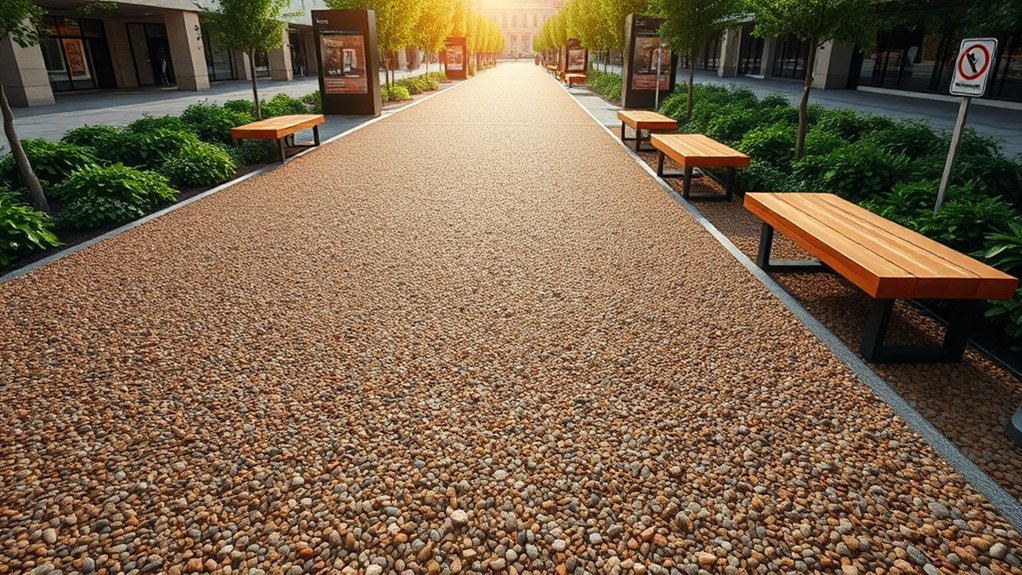Resin-bound gravel is an excellent choice for public spaces, meeting regulations while providing design flexibility. Ensure compliance with REACH regulations and obtain British Board of Agrément certification for your materials. Local councils often prefer permeable surfaces for better stormwater management, which can sometimes eliminate the need for planning permission. It’s also important to meet safety standards for slip resistance and accessibility. Regular maintenance can help extend the life of the surface. For more information on installation and environmental benefits, further research is recommended.
Key Takeaways
- Installers must complete diisocyanate training as per REACH regulations to ensure safety during resin-bound gravel installation.
- Materials for resin-bound gravel should have British Board of Agrément (BBA) certification to guarantee durability and compliance.
- Regular audits of installation practices are vital to ensure adherence to FeRFA guidelines and relevant regulations.
- Generally, resin-bound gravel driveways do not require planning permission, in line with UK regulations for sustainable development.
- Always check with your local council for specific installation requirements and to ensure compliance with public space regulations.
Application and Suitability of Resin-Bound Gravel
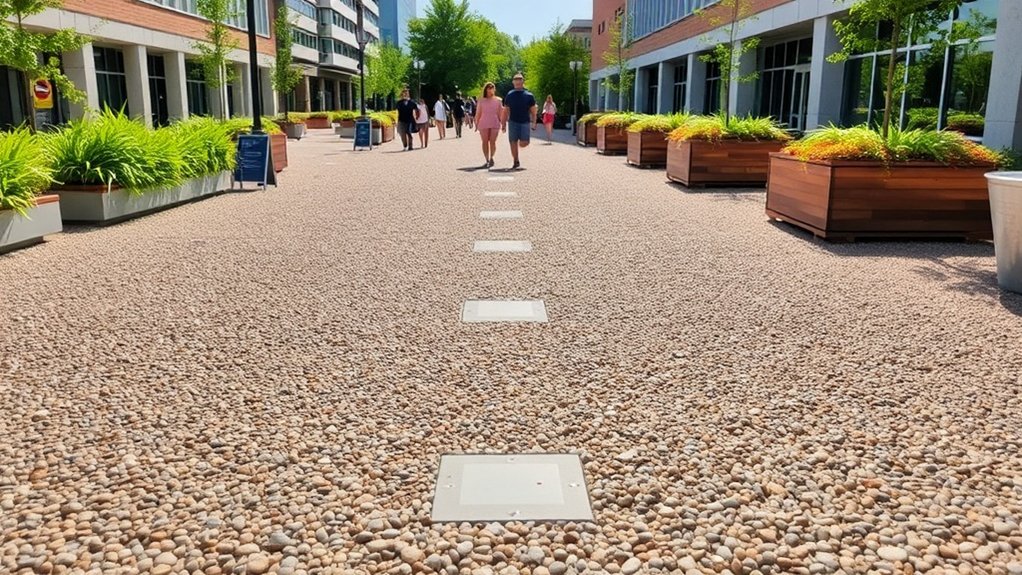
Resin-bound gravel is gaining popularity for its adaptability in various public spaces, making it an attractive option for urban planners and landscape architects. Its design flexibility allows for the creation of pedestrian areas, parks, and tree pits that enhance both functionality and appearance. You can choose from a range of colours and textures to ensure a cohesive look across urban environments, while its smooth finish provides ease of access for everyone. Additionally, its ability to support healthy trees by allowing rainwater to penetrate and nourish the soil further emphasizes its suitability for urban landscapes. Importantly, its permeable nature also helps manage stormwater effectively, reducing flooding and improving urban air quality. In rural areas, tailored blends can maintain a natural feel while offering long-lasting durability.
Regulatory Compliance in Public Spaces
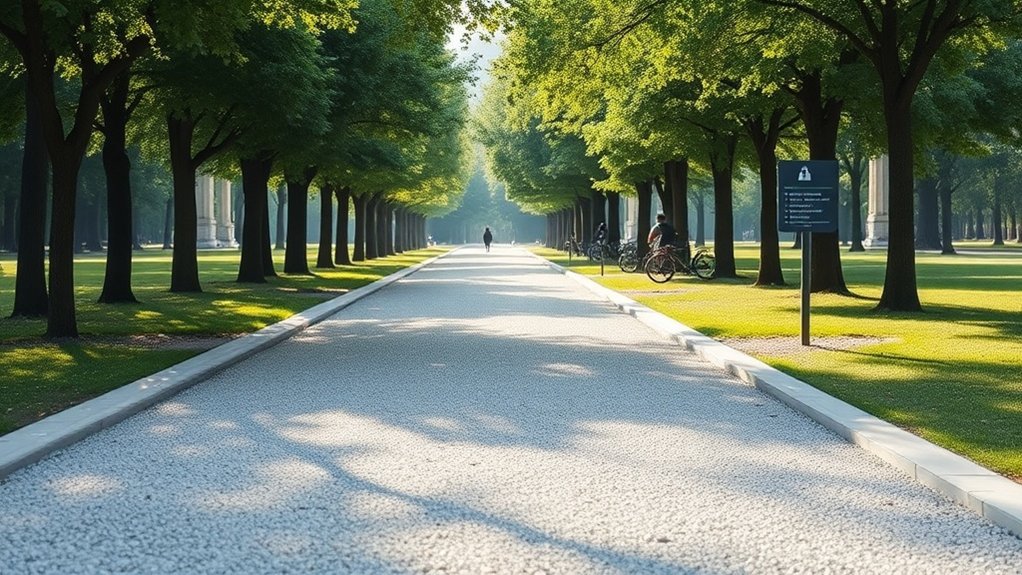
In public spaces, adhering to regulatory frameworks is crucial for ensuring safety and sustainability.
It’s important to understand installation guidelines and material sourcing for your projects. Here are three key compliance areas to consider:
- Training Requirements: Ensure that installers have completed the necessary diisocyanate training as per REACH regulations. Failing to do so can halt your project.
- BBA Certification: Check that the materials you use have British Board of Agrément approval. This certification confirms their durability through thorough testing and compliance with BBA approval standards.
- Quality Control: Conduct regular audits of installation practices to ensure they meet FeRFA guidelines, particularly regarding mixing ratios and environmental standards.
Planning Permission and SuDS Requirements
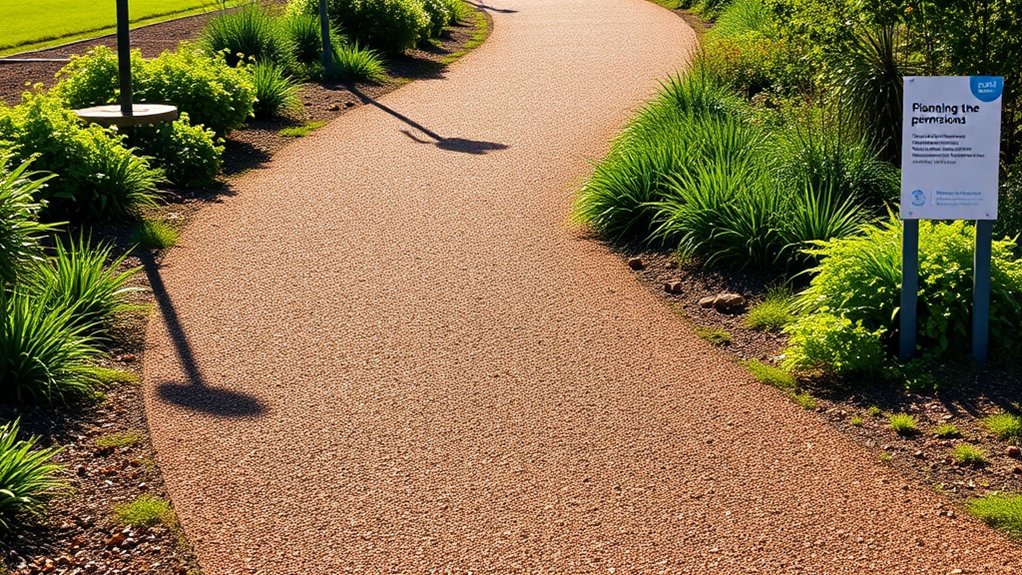
When planning to install a driveway, it’s crucial to understand the requirements for planning permission and Sustainable Drainage Systems (SuDS).
Generally, resin-bound gravel driveways don’t need planning permission because they’re permeable, which aligns with UK regulations promoting sustainable development. These surfaces allow rainwater to soak in, reducing surface water runoff and helping to prevent flooding. Their permeability also lightens the load on drainage systems and supports eco-friendly urban development. Additionally, these surfaces promote natural drainage which further contributes to managing stormwater effectively. Local councils usually favour these types of driveways as they meet regulations for front garden surfacing and assist in managing urban drainage effectively. Additionally, resin bound driveways are SUDS compliant, which further enhances their approval by local councils.
However, it’s always wise to check with your local council to confirm any specific requirements before proceeding with installation.
Safety Standards and Accessibility Features
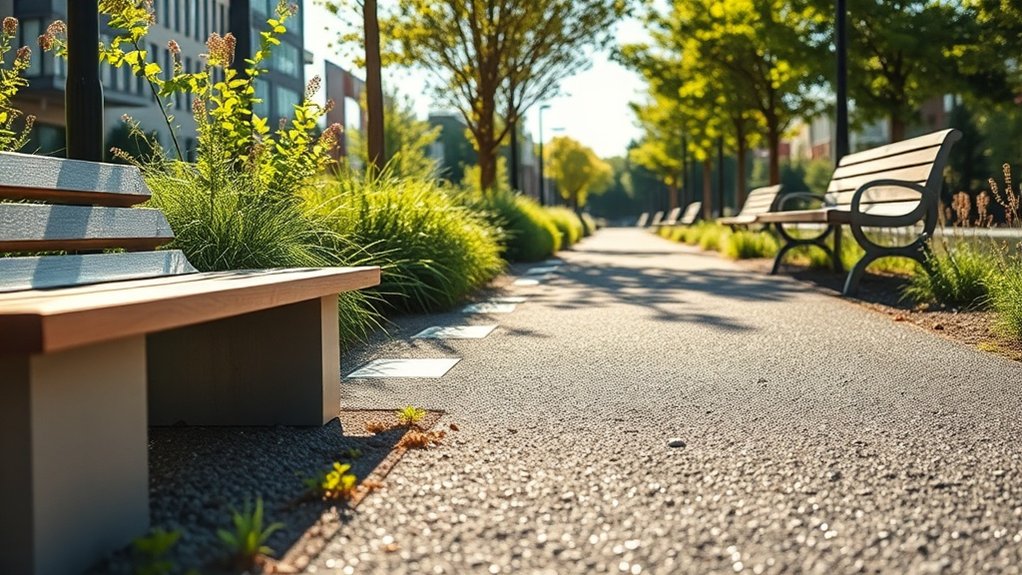
When it comes to safety standards in public spaces, resin-bound gravel stands out for its slip resistance and ability to minimise trip hazards. Its smooth, level surfaces meet wheelchair accessibility guidelines, making it safer for everyone. Proper installation and anti-slip additives enhance the grip of resin-bound gravel, ensuring that public spaces remain safe and accessible for all users.
Non-Slip Surface Benefits
A well-designed non-slip surface, like resin-bound gravel, significantly improves safety and accessibility in public areas.
Its slip resistance and textured finish offer key benefits:
- Natural Grip: The texture of the aggregate provides natural slip resistance, making it safer for pedestrians and those using wheelchairs or mobility aids.
- Weather Resilience: Anti-slip additives and resistance to ice help prevent slippery conditions, ensuring safety throughout the year.
- Low Maintenance: Seamless surfaces prevent the build-up of moss and debris, keeping them safe and slip-resistant over time.
Wheelchair Accessibility Compliance
When it comes to wheelchair accessibility, the right design and materials are crucial for safety and ease of movement. Resin-bound gravel surfaces provide a stable and smooth texture that benefits wheelchair users and those with mobility aids. Features such as gentle slopes and good drainage are vital for enhancing accessibility.
| Accessibility Feature | Description |
|---|---|
| Smooth Surface | Perfect for wheelchair use |
| Gentle Slopes | Minimises effort for mobility aid users |
| Colour Contrast | Helps those with visual impairments |
| Permeable Surface | Reduces puddles and icy spots |
| Durable Material | Ensures long-lasting quality |
Trip Hazard Reduction
To effectively reduce trip hazards in public spaces, using resin-bound gravel surfaces is crucial. This material not only boosts pedestrian safety but also supports vital trip prevention strategies:
- Smooth Surface: The seamless finish removes raised edges and uneven spots, thereby lowering the risk of trips.
- Customisable Aggregate Texture: Designed for better grip, it helps prevent slips and trips, particularly in wet weather.
- Permeable Drainage: This feature allows water to drain away efficiently, avoiding puddles that can cause slips.
Maintenance Considerations for Resin-Bound Surfaces
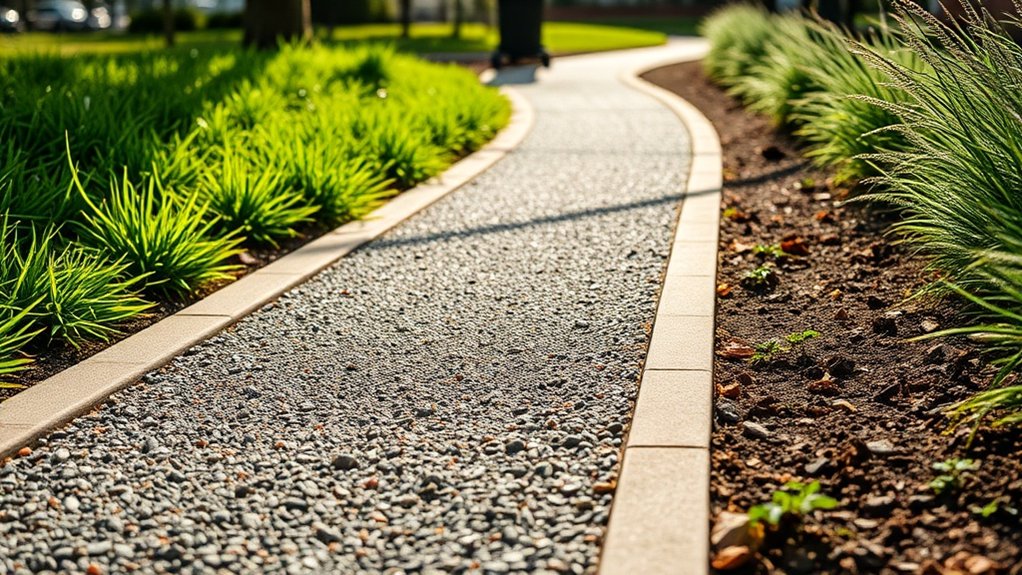
When managing resin-bound surfaces, it’s crucial to follow regular cleaning practices to extend their lifespan and keep them looking good.
Be proactive about addressing any damage and use effective repair methods. Establishing long-term maintenance strategies is also important.
By incorporating these considerations into your policy, you can ensure that public spaces remain functional and attractive.
For instance, a simple rinse with water and a soft brush can help remove dirt, while prompt repairs of any cracks can prevent further damage.
Regular Cleaning Requirements
Regular cleaning is crucial for keeping resin-bound surfaces in good condition. Neglecting this can lead to serious long-term problems.
To maintain cleanliness and ensure proper drainage, follow these straightforward guidelines:
- Weekly sweeping: Use a stiff broom or a non-metal leaf blower to clear away leaves and debris. This helps prevent blockages that could affect drainage.
- Monthly hosing: Rinse the surface gently with clean water. Avoid using harsh chemicals, as they can damage the resin.
- Seasonal deep cleaning: Pressure wash once or twice a year to remove stubborn dirt. Make sure to keep the nozzle at least 20 cm away from the surface to avoid any damage.
Damage Repair Techniques
To keep resin-bound surfaces in top condition, regular cleaning isn’t enough; you need to address repairs promptly and effectively.
Start by checking for cracks, holes, or loose stones. Use a pressure washer or stiff brush to clean these areas, ensuring all debris is removed and the surface is completely dry for better adhesion. Smooth the edges of any cracks with sandpaper to improve bonding.
Next, prepare your repair material by mixing the resin binder with aggregate as per the manufacturer’s guidelines, paying attention to colour consistency.
Use a trowel to apply the resin evenly, filling in cracks and layering for larger repairs. Lastly, follow the recommended curing times and keep the repaired areas free from foot traffic to achieve a lasting finish.
This proactive approach will help maintain both the appearance and structural integrity of your resin-bound surfaces.
Long-Term Maintenance Tips
To ensure the longevity and performance of resin-bound surfaces, it’s important to follow a straightforward long-term maintenance plan. This not only keeps the surface looking good but also promotes sustainability.
Here are three key tips:
- Regular Visual Inspections: Check for stains, weeds, and any signs of wear regularly. Address any problems straight away to avoid expensive repairs.
- Cleaning Protocols: Sweep the surface monthly and give it a pressure wash once a year using pH-neutral detergents. This keeps it clean without damaging the resin.
- Seasonal Adjustments: In autumn, clear away leaves quickly to prevent moss growth. In winter, use rock salt for traction, but ensure it’s safe for the surface.
Environmental Impact and Aesthetic Advantages
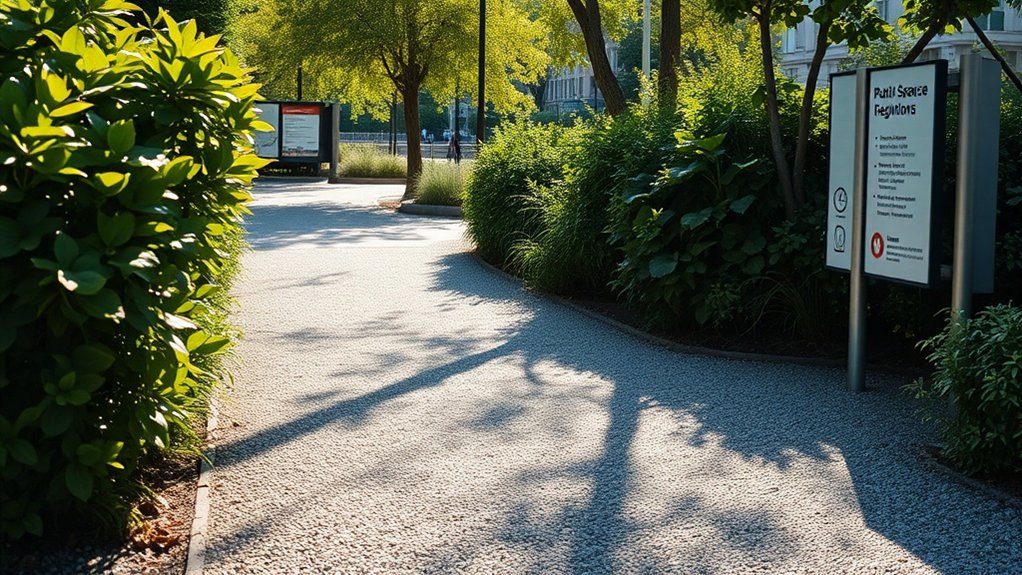
Resin-bound gravel is an excellent choice for public spaces, striking a balance between functionality and aesthetics.
Its water-permeable design allows rainwater to filter through, reducing runoff and helping to keep local waterways clean. With a variety of colours and textures available, resin-bound gravel can create attractive, seamless surfaces that enhance any area.
Moreover, its durability means fewer replacements are needed, which helps cut down on waste. The surface also reflects light, improving safety, and supports local biodiversity.
Frequently Asked Questions
How Long Does Resin-Bound Gravel Take to Cure After Installation?
Resin-bound gravel usually needs around 6-8 hours to cure for light foot traffic, while full curing can take up to 24 hours. Factors such as temperature and surface conditions can significantly affect these times. For instance, a warm, sunny day may speed up the process, whereas cooler, damp conditions could prolong it.
Can Resin-Bound Gravel Be Installed Over Existing Surfaces?
Yes, you can install resin-bound gravel over existing surfaces, but it’s crucial to prepare the surface properly. Using the right installation techniques ensures durability and prevents issues such as cracking or peeling due to poor adhesion or unstable foundations. For example, if you’re laying it over concrete, ensure the surface is clean and free from any debris to achieve the best results.
What Types of Aggregates Are Commonly Used in Resin-Bound Gravel?
In resin-bound gravel, you’ll often find stone aggregates such as granite and quartz, typically sized between 2-5mm. This size range strikes a balance between durability and visual appeal. The choice of resin ensures a strong bond and resistance to the weather.
Is Resin-Bound Gravel Suitable for Commercial Parking Lots?
Yes, resin-bound gravel is a durable and attractive option for commercial parking lots. It can handle heavy traffic while providing a visually appealing surface that boosts branding and improves safety. For instance, many businesses choose it for its resilience and the variety of colours and finishes available, making it a smart choice for any commercial space.
How Does Temperature Affect the Installation of Resin-Bound Gravel?
Temperature extremes can significantly affect the installation of resin-bound gravel. In hot weather, the resin cures quickly, which can result in an uneven finish. Conversely, low temperatures slow down the curing process and may compromise the adhesion, risking structural issues down the line if not addressed. For instance, if you’re laying gravel on a sunny day, it’s crucial to work swiftly to avoid these problems. Similarly, during colder months, consider using heaters or waiting for a milder day to ensure a successful installation.
Conclusion
In summary, using resin-bound gravel in public spaces can create safe, attractive, and functional areas. It’s essential to comply with local regulations, secure necessary planning permissions, and maintain the surfaces properly. For instance, a well-maintained resin-bound pathway can enhance accessibility for all users, including those with mobility challenges. By paying attention to these factors, you can foster community engagement and ensure your projects are environmentally friendly.
